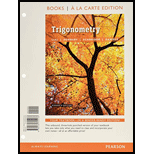
Concept explainers
Amperage, Wattage, and Voltage Amperage is a measure of the amount of electricity that is moving through a circuit, whereas voltage is a measure of the force pushing the electricity. The wattage W consumed by an electrical device can be determined by calculating the product of the amperage I and voltage V. (Source: Wilcox. G. and C. Hesselberth, Electricity for Engineering Technology, Allyn & Bacon.)
(a) A household circuit has voltage
V = 163 sin 120πt
when an incandescent light bulb is turned on with amperage
I = 1.23 sin 120πt.

Graph the wattage W — VI consumed by the light bulb in the window [0.0.05] by [ -50. 300].
(b) Determine the maximum and minimum wattages used by the light bulb.
(c) Use identities to determine values for a. c. and w so that W — a cos(wt) + c.
(d) Check by graphing both expressions for W on the same coordinate axes.
(e) Use the graph to estimate the average wattage used by the light. For how many watts (to the nearest integer) would this incandescent light bulb be rated?
Want to see the full answer?
Check out a sample textbook solution
Chapter 5 Solutions
Trigonometry, Books a la Carte Edition plus MyLab Math with Pearson eText -- Access Card Package (11th Edition)
- Find the polar representations of a point which has -л<О≤л and is symmetrical to the given point with respect to the origin. (√2.- 1/1) π 4arrow_forwardFind the area of a triangle formed by the pole and the two points with polar coordinates. π A 5, - B(10, 2π)arrow_forwardAre the steps I made allowed? I am verifying a trig identity.arrow_forward
- Define with normS (n) (22) | I(M) WK.P() ⑥HK (~) H' (~~) and H) 2² (^_^)arrow_forwardPlease provide a clear and detailed solutionarrow_forwardPlot each point given its polar coordinates. Then, give another pair of polar coordinates for the same point with the opposite radius and angle 0 ≤ 0 < 2π (or 0 ≤ 0 < 360°). (-6, 120°)arrow_forward
- Find two additional polar representations of the given point such that one has the same sign as r but the opposite sign of 0, and the other has the opposite sign of r but the same sign as 0. 3, - π 6arrow_forwarde consider the problem -((1+x)))= 0 XE U(0) = 0, 'U(1)=\@Sind the analytical sol and he Find the Variational form and find Matrix A and b? consider the Variational form a (u,v)-(SV) where acu,v) = vdx prove that YVE H. (0,1),i=1, 2, \\-\ a(vi)=-v(x-1)+2V(xi)-(X;+1)] Where Vn is usual basis of hat functions. Consider the Problem Au=f and u= du=0 0 a with bilinear formalu,v) = SAU. AV r Prove that alu, v). V-ellPitic. and aluv) is continuous..arrow_forwardThe resistance, R, of a conductor is directly proportional to its length, 7. If the resistance. of 3.80 km of a certain transmission line is 121 ohms, find the resistance of 74.9 km of that line. Round your answer to 3 significant digits. Ωarrow_forward
- Algebra & Trigonometry with Analytic GeometryAlgebraISBN:9781133382119Author:SwokowskiPublisher:Cengage
 Algebra: Structure And Method, Book 1AlgebraISBN:9780395977224Author:Richard G. Brown, Mary P. Dolciani, Robert H. Sorgenfrey, William L. ColePublisher:McDougal Littell
Algebra: Structure And Method, Book 1AlgebraISBN:9780395977224Author:Richard G. Brown, Mary P. Dolciani, Robert H. Sorgenfrey, William L. ColePublisher:McDougal Littell College AlgebraAlgebraISBN:9781305115545Author:James Stewart, Lothar Redlin, Saleem WatsonPublisher:Cengage Learning
College AlgebraAlgebraISBN:9781305115545Author:James Stewart, Lothar Redlin, Saleem WatsonPublisher:Cengage Learning  Algebra and Trigonometry (MindTap Course List)AlgebraISBN:9781305071742Author:James Stewart, Lothar Redlin, Saleem WatsonPublisher:Cengage Learning
Algebra and Trigonometry (MindTap Course List)AlgebraISBN:9781305071742Author:James Stewart, Lothar Redlin, Saleem WatsonPublisher:Cengage Learning Holt Mcdougal Larson Pre-algebra: Student Edition...AlgebraISBN:9780547587776Author:HOLT MCDOUGALPublisher:HOLT MCDOUGAL
Holt Mcdougal Larson Pre-algebra: Student Edition...AlgebraISBN:9780547587776Author:HOLT MCDOUGALPublisher:HOLT MCDOUGAL Glencoe Algebra 1, Student Edition, 9780079039897...AlgebraISBN:9780079039897Author:CarterPublisher:McGraw Hill
Glencoe Algebra 1, Student Edition, 9780079039897...AlgebraISBN:9780079039897Author:CarterPublisher:McGraw Hill





